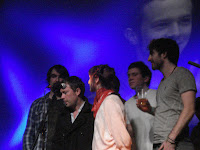As a Rotary Ambassadorial Scholar, I tend to focus more on the Rotary and ambassadorial portions in this blog – as the Rotary Foundation puts it, “furthering world understanding and peace through increasing awareness of and respect for cultural differences.” But another one of the program objectives, more along the scholar lines, is “developing leaders who can address the humanitarian needs of the world community,” so I figured I’d share a bit of the scholar side on occasion as well (also because my life this week has consisted primarily of commuting to and from class, my flat, and the library, and not so much of the fun travel/cultural insights side).
There are a number of ways that scholars in Ireland are addressing the humanitarian needs of the world through programs as varied as Race, Ethnicity, and Violence; Urban Planning with an emphasis on post-conflict settings; or International Management with a focus on increasing supply chain efficiency when delivering emergency food aid (decreasing the time it takes to get to food to the victims of famine or other natural disaster). As for my program, I chose to spend the year studying International Peace Studies.
So what exactly does that entail? Well, a variety of topics. This term, I have courses on the Politics of Peace and Conflict; the United Nations and Peacekeeping; Conflict Resolution and Nonviolence; and Ethics in International Affairs. The courses are marked (graded) a bit differently here than in the US, in the sense that my entire mark (grade) is based on a single 20-page paper written on one particular topic related to the course, rather than multiple shorter essays or attendance or facilitating discussions as is more common in the US.
At the moment, I’m writing a paper on the roles that the US and China played in the UN Security Council with regard to international intervention in the conflicts in the southern and western regions of Sudan for my class on the UN and Peacekeeping. In the wake of the mass atrocities of the 1990s that occurred in such states as Rwanda, Burundi, and the former Yugoslavia, a new set of international principles emerged called the Responsibility to Protect, which dictates that the government of each nation has a responsibility to protect its own citizens against mass atrocities, and the international community has a responsibility to assist the nation in doing so, but if a the government fails to protect its own citizens, the international community has a responsibility to intervene to stop the mass atrocities. (Note: the responsibility to protect, which provides justification for military intervention, should not be confused with humanitarian intervention, which aid organizations prefer to be strictly non-military and humanitarian only, such as the recent case of providing food and medicine to victims of famine in Somalia). Where the US was interested in fostering some sort of intervention in Darfur through the UN under the international norm of the Responsibility to Protect, China was only willing to do so if the government of Sudan was willing to accept a UN peacekeeping mission (which it was not), because such intervention against the will of the government would jeopardize the international principle of non-intervention in the internal affairs of a sovereign nation, and China certainly didn’t want to enable future meddling of the international community into it’s own domestic affairs.
The desire on the part of the international community to broker a peaceful resolution to the conflict in the south of Sudan during the early 2000’s lead to inaction (or severely delayed action anyway) in Darfur, western Sudan, with regard to stopping the acts of ongoing genocide committed as the peace negotiators did not want to ostracize the government of Sudan in Khartoum. While individual member nations to the UN did assist with the peace negotiations that lead to the 2005 Comprehensive Peace Agreement and the later creation of the independent nation of South Sudan on July 9, 2011, the UN Security Council itself did not intervene or invoke the principle of the Responsibility to Protect.
Arguing over the international principles of whether it’s legal to intervene is more of a constructivist argument, but of course, there were also the ‘realist’ arguments that the US had already committed its forces to wars in Iraq and Afghanistan and couldn’t commit further troops to Sudan, and that Chinese interests own the vast majority of oil in Sudan, and international intervention would jeopardize those so of course China opposed intervention on those grounds as well. Still, these conflicting principles of whether or not to intervene in the domestic affairs of a sovereign nation when innocent people are being murdered at the hand of the state (or when the state is turning a blind eye and enabling non-state groups to commit the atrocities), and if so, at what point enough people have died to justify intervention, are (unfortunately) likely to continue arise in the international arena in the future.











